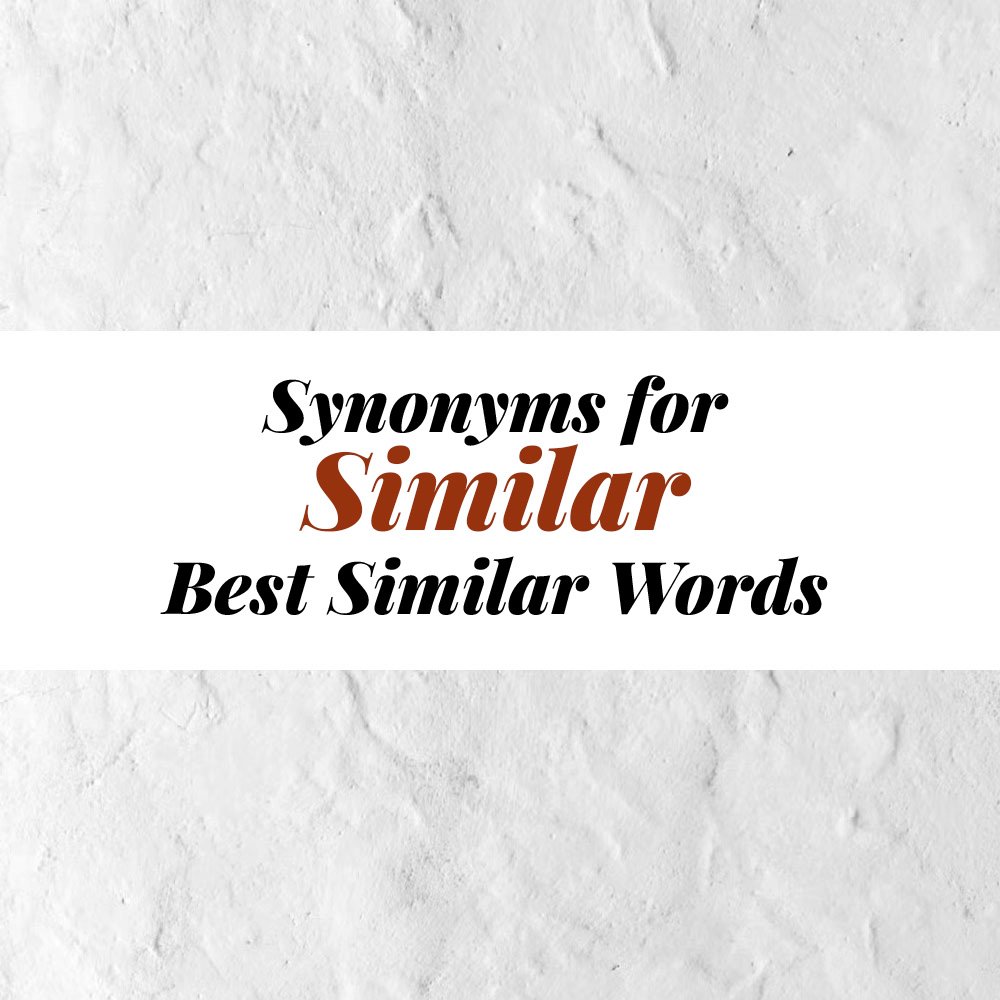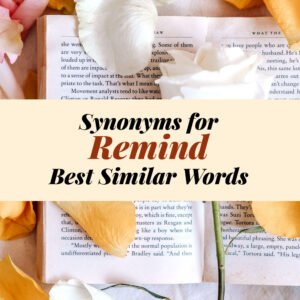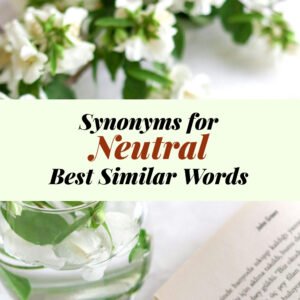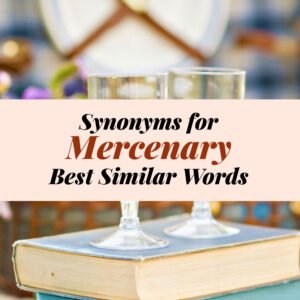When we want to describe things that look alike, act alike, or feel alike, we often use the word “similar.” But sometimes, repeating the same word again and again can feel boring. That is when synonyms become very useful. Words like “alike,” “comparable,” or “matching” can replace “similar” in many sentences. In this article, you will discover 21 helpful alternatives with meanings and examples.
| Synonym | Meaning | Example |
|---|---|---|
| Alike | Nearly the same in appearance or nature | The twins look very much alike. |
| Comparable | Able to be compared because they are nearly the same | The two phones are comparable in price. |
| Parallel | Having a relationship that is alike in some way | Her story runs parallel to his. |
| Analogous | Similar in certain qualities | The two cases are analogous. |
| Resembling | Looking or seeming like something else | That cloud is resembling a dragon. |
| Equivalent | Equal in value, amount, or meaning | Ten dimes are equivalent to one dollar. |
| Corresponding | Matching or relating in some way | He received the corresponding reward for his work. |
| Matching | Fitting together because of likeness | They wore matching jackets. |
| Identical | Exactly the same | The two cars are identical in model. |
| Homogeneous | Of the same kind or nature | The group was homogeneous in culture. |
| Kindred | Related or alike in spirit or character | They felt kindred emotions. |
| Related | Connected or associated | The two topics are closely related. |
| Uniform | Always the same or consistent | The houses were uniform in design. |
| Respective | Relating separately but in a similar way | The children returned to their respective seats. |
| Commensurate | Equal in measure or proportion | The salary is commensurate with experience. |
| Consistent | Acting or done in the same way | Her results are consistent with expectations. |
| Symmetrical | Balanced and similar on both sides | The face was perfectly symmetrical. |
| Congruent | Matching in shape or agreement | The two triangles are congruent. |
| Equivalent | Having the same worth or function | His actions were equivalent to a promise. |
| Resemblant | Showing likeness | His features are resemblant of his father. |
| Approximate | Close to something but not exact | The two figures are approximate in value. |
21 Different Ways to Say SIMILAR: Another Word for SIMILAR
Alike
The word “alike” is one of the most common alternatives for “similar.” It describes two or more things that share the same qualities, appearance, or nature. For example, when we say siblings look alike, it means they share visible features. This word is often used for people, objects, or even ideas. Using “alike” can make your sentence sound smoother and less formal compared to “similar.” It works best when you want to show closeness in form or likeness in behavior without being too strict or technical.
- The houses on this street look alike.
- Their voices sound alike on the phone.
- The two paintings are alike in color.
Comparable
“Comparable” shows that two or more items can be placed side by side and measured against each other. It means they are close enough in nature, price, quality, or size that you can make a fair comparison. This word is often used in discussions about products, achievements, or statistics. When something is comparable, it doesn’t mean it is exactly the same but that the differences are small enough to allow evaluation. It’s a useful synonym when talking about choices or options.
- The cost of this laptop is comparable to that one.
- Their skills are comparable in level.
- The service here is comparable with top restaurants.
Parallel
The word “parallel” often refers to lines that run side by side, but it can also be used for situations, stories, or experiences that are alike in some way. When two events are parallel, they happen in similar ways or share a strong connection. This word brings an image of two things moving together without touching. It works well when writing about journeys, comparisons, or linked events.
- Her career runs parallel to her brother’s.
- Their lives took parallel paths after school.
- The two studies show parallel findings.
Analogous
“Analogous” is often used in more thoughtful or detailed discussions. It shows that one thing is similar to another in some important way, even if they are not exactly the same. For example, the human eye and a camera can be called analogous because they work in similar ways. It is helpful when comparing concepts, systems, or situations.
- The two situations are analogous in many respects.
- This machine is analogous to an engine in design.
- Their struggles are analogous to what we faced.
Resembling
“Resembling” is often used when something looks like something else. It highlights appearance and outward features. If a picture is resembling another, it means the look is almost the same. This word is flexible and can be used for people, objects, or abstract forms. It shows closeness but allows for slight differences.
- That child is resembling her mother.
- The statue is resembling a famous leader.
- This design is resembling last year’s pattern.
Equivalent
“Equivalent” means equal in value, function, or meaning. It is often used in math, money, and general comparisons. If one amount is equivalent to another, both represent the same worth. It can also apply to ideas or actions that carry the same effect or importance. This word adds a sense of balance and fairness.
- A euro is roughly equivalent to a dollar in some cases.
- His promise is equivalent to an agreement.
- The pain she felt was equivalent to losing everything.
Corresponding
The word “corresponding” means something matches or relates directly to something else. It is often used when comparing two sets of things, where each part has a partner. For example, a student’s effort might have a corresponding result. It gives the idea of order, connection, and balanced relationship.
- The map shows the corresponding regions.
- His income rose with the corresponding work hours.
- Each problem had a corresponding solution.
Matching
“Matching” is about things that go well together because they are the same in color, style, or shape. People often use this word for clothing, accessories, or designs. Matching items are pleasing to look at because they connect visually. It also shows harmony and balance.
- They wore matching rings.
- Her shoes are matching her bag.
- The curtains are matching the walls.
Identical
The word “identical” is stronger than “similar.” It means exactly the same in every way. Identical objects, twins, or items cannot be told apart easily. This word is often used when no difference exists at all between two things. It carries a strict sense of sameness.
- The two reports are identical.
- These shirts are identical in size.
- The twins are almost identical.
Homogeneous
“Homogeneous” refers to something made of the same kind, material, or nature. It is often used for groups, mixtures, or communities where everything is uniform. For example, a homogeneous group of students may share the same background. This word is useful in science, society, or design.
- The class was homogeneous in age.
- The mixture must be homogeneous to work.
- The team was homogeneous in skills.
Kindred
“Kindred” is used to describe things or people that are alike in spirit, feeling, or nature. It is often used when talking about emotions, beliefs, or connections between people. A kindred soul feels close because of shared thoughts or values. This word adds warmth and connection.
- They are kindred spirits.
- Their kindred ideas brought them together.
- She found kindred hearts in the group.
Related
The word “related” shows that two or more things are connected in some way. It can mean family ties, subject connections, or even shared qualities. If topics are related, they link together naturally. This synonym is widely used in daily talk and formal settings.
- These two topics are closely related.
- She is related to him by marriage.
- The jobs are related in purpose.
Uniform
“Uniform” means always the same and not changing. It describes appearance, behavior, or patterns that do not vary. This word shows regularity and balance. For example, buildings can be uniform in design, or work can be uniform in quality. It highlights stability and sameness.
- The houses are uniform in shape.
- His answers were uniform across tests.
- The fabric is uniform in color.
Respective
The word “respective” means belonging separately but in a way that shows similarity. For example, students go back to their respective seats, each one returning to their own. It describes things that are divided but still share a common structure.
- They returned to their respective homes.
- The teams went to their respective fields.
- The players held their respective awards.
Commensurate
“Commensurate” means equal in measure, amount, or degree. It is used to show fairness between effort and reward, or between size and value. For example, a salary can be commensurate with experience. This word is often used in work, learning, or achievement.
- His pay was commensurate with his skills.
- The punishment was commensurate with the crime.
- The benefits are commensurate with the cost.
Consistent
“Consistent” means always acting or behaving in the same way. It shows reliability and regularity. A consistent pattern or result means it keeps happening the same way. This synonym is useful when talking about habits, performance, or evidence.
- Her work is consistent with her goals.
- The rules must be consistent across teams.
- His answers are consistent every time.
Symmetrical
“Symmetrical” means balanced on both sides. A symmetrical face or design looks the same when divided in half. It highlights balance and harmony. This word is common in art, design, and description of objects or nature.
- The building is symmetrical in design.
- Her face is perfectly symmetrical.
- The pattern is symmetrical on both sides.
Congruent
“Congruent” means fitting together perfectly in shape, size, or agreement. In math, congruent figures are identical in form. In daily talk, it can mean ideas or actions that match well. It shows perfect alignment and fit.
- The two triangles are congruent.
- Their ideas are congruent with the plan.
- His actions are congruent with his words.
Equivalent
“Equivalent” is another way to say equal or having the same value. It can apply to money, effort, meaning, or action. This word stresses fairness and sameness. It often appears in discussions of worth or exchange.
- Ten nickels are equivalent to half a dollar.
- His silence was equivalent to agreement.
- The two offers are equivalent in value.
Resemblant
“Resemblant” is less common, but it means showing likeness or looking like something else. It can describe features, designs, or traits. It gives the sense of being similar without being exact.
- His face is resemblant of his father’s.
- The statue is resemblant of an old hero.
- Their styles are resemblant in detail.
Approximate
“Approximate” means close to something but not exact. It is often used for numbers, amounts, or shapes that are nearly the same. This synonym shows near likeness but leaves room for difference.
- The two figures are approximate in value.
- Their ages are approximate.
- The cost is approximate to last year’s.

Final Thoughts
Synonyms for “similar” help us describe likeness in many ways. Each synonym gives a new shade of meaning, whether close resemblance, perfect sameness, or equal worth. By using different words, we make our speech and writing richer. Try practicing these 21 options whenever you want to replace “similar.”








